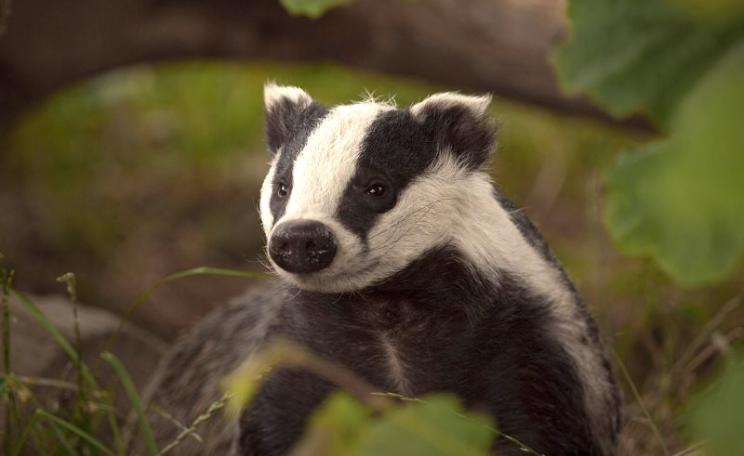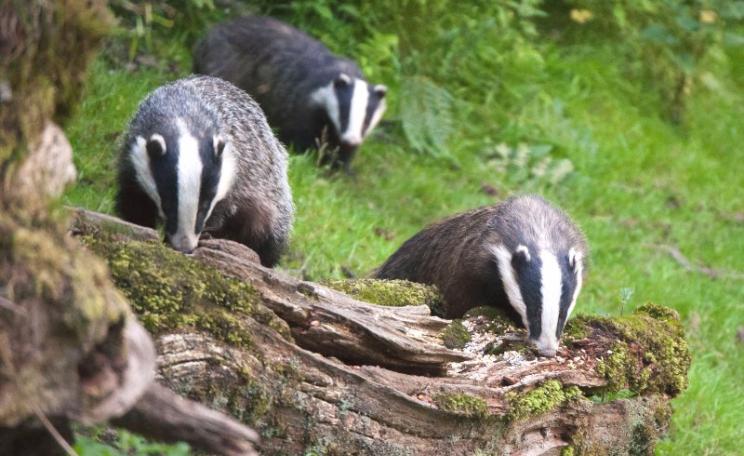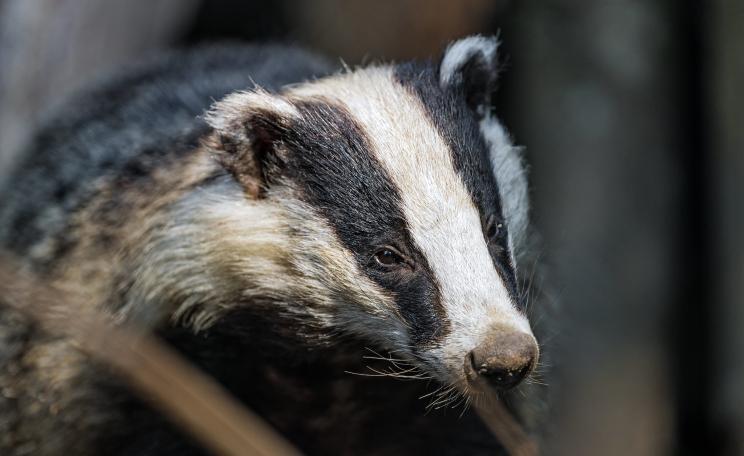Farmers deserve better than this and so do our cows. Public money must be better spent and farmers protected. It has been a salutary lesson for scientists making assumptions and modelling data in unsafe conditions.
The Science Symposium at Imperial College, London on 28th March revealed new insights to both science and politics of this insidious disease.
Following science workshops in Oxford and Cambridge in recent weeks supported by The Badger Trust and Eurobadger, the all-day London meeting, with over 20 speakers was attended by around 250 delegates and adroitly managed by the Brian May Save Me charity.
After an introduction from John Krebs, the name behind the Randomised Badger Culling Trial (RBCT), Government Chief Scientist Ian Boyd wanted to 'set the tone' for the meeting. He left promptly afterwards, stating that the (£3 Billion) bovine tuberculosis (bTB) issue could only justify so much of his time.
Views expressed in his Christmas report, that politicians only take so much notice of government scientists, perhaps has bearing on his recent decision to leave his post. If allowed to be ruthless, he claimed that the cattle bTB problem could have been solved quickly as in the past, but that was not today's way.
Was this cryptic message a reference to the test and herd depopulation that brought bTB crashing down in just four years in the early 1960s?
TB control on the never-never (literally)
There was no mistaking his messaging that the drip-feed 2011 bTB disease control agri-policy, like some terrible mortgage or pay-day loan, was DEFRA's preferred economic approach, contrasting with the short-sharp intensive action seen previously in both bTB and Foot and Mouth control.
It was, Boyd argued "a sociological problem concerning people who own cattle", using the rather odd analogy "scientific advice about fisheries tends to wrongly assume that fisheries management is about managing fish, when we can normally only manage those who fish."
Not quite letting his political masters off the hook, and bearing in mind the close ties between key government representatives and supporters and the land-based industries, Boyd picked his words carefully, hinting that farmers might, in effect be seen to be being "subsidised to tolerate the disease".
Thus confirming, as he dashes for the door, what many objectors have feared. The policy really represents post economic-crash tactics to live with the disease as the cheap short-term option, irrespective of its implication for farmers or the environment and long term cost.
And economics were also apparent at the previous days Westminster Hall Debate, following Simon King's successful mass petition to "End the badger cull". Opposition MPs Paul Flynn and Angela Smith, with others bombarded the government with questions but were supplied with few answers.
Farmers deserve better than this and so do our cows. Public money must be better spent and farmers protected. It has been a salutary lesson for scientists making assumptions and modelling data in unsafe conditions.
SNP's Paul Monaghan, echoing the words of Sefan Hogan of the Northern Ireland TB Strategic Partnership Group regarding their hopes for an Integrated Eradication Programme, suggested to beleaguered Minister for Defra George Eustice, that wasn't it the case that the government "could have as much Bovine TB as it was prepared to pay for?"
Gamma interferon works! Best not use it too much then ...
Back at the Imperial College Symposium, Welsh Chief Veterinary Officer Christianne Glossop pointed to "the battle raging in the countryside" and explained the more proactive and pragmatic "keep it out / find it fast / stop it spreading / stamp it out" approach of the Welsh Assembly in Wales.
Gamma interferon testing had been brought in to bolster the poor-performing tuberculin skin test and was producing promising early results.
Nigel Gibbens, like George Eustice the day before in Westminster, limply used the same phrase in relation to use of gamma testing in England: "we will use it more". No commitment to compulsory and free issue across England though.
This is the method that could root out the disease, and send infected cattle for slaughter as necessary, in a well-planned way. England has plans to use gamma in the failed Pilot badger culling areas, which will further muddy any attempts to analyse those already scrambled events.
Gibbens indicated twice that the government culling policy was now 'rolled out', when no such formal decision has been taken. He seemed to indicate that there might be large expansion of badger culling in around 20% of the High Risk Area in 2017 - another 15,000 badgers condemned, with many new areas to face the divisive disruption waste and local misery that such activity brings.
Policy-based science
However at least to me, for the first time, government scientists were being honest about the severe constraints surrounding how their science fits the political direction of their masters. Otherwise known as 'policy-based science'. It was refreshing for them to be so open and honest on such a difficult matter, akin to yelling 'help' from the roof.
Most telling, both Boyd and Gibbens gave the "not in our lifetime" view on bTB control - an apparent surrender both to the disease and to the political masters who think economy-led management of livestock disease is a sane approach. Perhaps they meant not in the lifetime of the soon to play-out Brexit hard-times for farming.
And the symposium had no immediate solace for the badger protection world. The data from 20 years of failed badger culling in Republic of Ireland (ROI) was presented as if it had statistical significance.
There was an ROI "vaccination programme to come" sweetener; an exit strategy to the pointless €100 million decimation of badgers in the disrupted Irish ecosystems. Hardly reflecting the Brussels inspections, that has given Dublin notice to think again in recent years.
Everywhere, vaccination of both cattle and badgers had its 'jam maybe tomorrow' promise and the difficulties and delays of progressing research re-stated.
What does work, and what doesn't
However, the Symposium did have some brighter moments with molecular biologist Cath Rees from Nottingham University showing how work carried out on the edge of legal restrictions to experimentation had enabled the refinement of a bacteriophage blood test, offering a potential new dawn for bTB testing.
Gareth Enticott from Cardiff University quoted the "mythology of New Zealand as a TB policy leader" showing how governments mismanage their farming community at their peril. Amie Adkin from the APHA gave useful insight into farmer attitudes towards risk-based trading.
James Wood from Cambridge University Vet School outlined the knowns, unknowns and goals in BTB testing and the quest for the Divergence test to tell vaccinated cattle apart from diseased ones.
Much to the chagrin of some bTB modellers, a new review collecting data from a wide range of studies shows that the tuberculin skin test fails not only to detect up to 20% but sometimes up to 50% of bTB reactor cows.
No wonder the disease is perpetuating itself. No wonder ordinary work-a-day farmers are angry about the uncertainty in the current measures, with no end in sight.
Enough #fakescience to shake a stick at! Including the RBCT
As it began however, the Symposium was upstaged by Zoological Society researcher and RBCT veteran Rosie Woodroffe, letting rip at Defra, according to a BBC report, accusing the government of cherry-picking evidence and forming "fake science" to justify their approach to the Pilot badger culls in England.
Strong words from a DEFRA-funded researcher whose own work was also under question in the same week. Having restated her view that badgers are responsible for 1 in 20 herd breakdowns and up to 50% of bTB generally in herds, she offered her latest hypothesis that cows may catch bTB by inhaling over badger latrines.
Tim Coulson (of the original Pilot Cull Independent Expert Panel) from Oxford University had earlier explained government approach to badger population estimates in pilot culling zones. His deadpan treatment exposed with cold clarity the total farce and mockery that is DEFRA and Natural England's twisting and turning to make evidence fit the policy.
The symposium expert panel looked to the RBCT team when asked why, given the RBCT (upon which the 2011 English bTB Policy hangs) used confirmed rather than all reactor breakdown data in its final 2007 analysis, the current government policy was still valid. Since completion of the RBCT, a lack of visible lung lesions at post-mortem is no longer viewed as a non-Tb contact.
This oversight is the time-bomb in both Lords Zuckerman's (1980) & Krebs (1997) reviews, and continued into the 2007 ISG report (see page 93-96). In fairness, in 2007 Bourne pointed towards poor post-mortem culturing as the reason that the disease was overlooked in 'unconfirmed' reactors.
Analysis based on all breakdowns (confirmed and unconfirmed) does not show any significant effect of proactive culling of badgers on herd breakdowns. So science now says that the RBCT made no meaningful contribution to the question of whether badgers pass bovine TB to cattle.
The fall of the proactive cull benefit science, is now added to the insignificant reactive cull findings (trials stopped prematurely), and the beleaguered perturbation hypothesis that in 2007 was rejected by the Chief Scientist of the day and others.
The RBCT has not born the test of time well. These are fatal blows to the RBCT and its derivative science papers as we know it, now trapped haplessly in peer-reviewed immortality.
It is shocking when one realises how they were used to underpin the millions of pounds of research efforts over the last decade, and indeed the 2011 bTB policy and its clumsy progress. As Krebs himself recently commented; "we must acknowledge as scientists that we don't always get it right. Models make assumptions, labels slip in freezers."
The answer: stop the cull, roll out the gamma testing
As for the policy? Well the correct procedure would be for MPs to require 'Suspension'. The irony is that the RBCT took a year-off during its progress due to foot and mouth, so pausing for a year now to rethink would even be consistent with the current policy, based on the RBCT methods.
However, given the sums and likely outcomes indicated, it is hard to understand how badger culling could continue as a credible policy, and the bTB Symposium marks the end of its era.
Farmers deserve better than this and so do our cows. Public money must be better spent and farmers protected. It has been a salutary lesson for scientists making assumptions and modelling data in unsafe conditions.
What next? Well the government can use its badger cull savings on rolling out gamma testing with the SICCT test, as in Wales and save as much of the £2 billion that would be frittered stringing it out to 2038 and beyond. This would be following, what international experts have been advising for years; bringing down bovine TB in England to acceptable levels.
And the badgers? The cats and the moles and worms and the deer and everything else in what now look like the phoney reservoir? Well some of work on the poorly understood epidemiology that was overlooked in the 1990s can be carefully started, in the normal way.
It is called evidence-based science and you ignore it at your peril.
Tom Langton is a consulting ecologist to government, business and industry and a voluntary sector volunteer, more recently working on assisting small pressure groups in their legal opposition to destruction of species and habitats in Europe.







